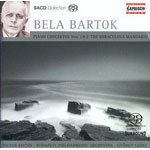
Piano Concertos: No. 1 & No 2; The Miraculous Mandarin Suite
 $36.00
Out of Stock
$36.00
Out of Stock6+ weeks add to cart
BARTOK
Piano Concertos: No. 1 & No 2; The Miraculous Mandarin Suite
Zoltan Kocsis (piano) / Budapest Philharmonic Orchestra. Gyargy Lehel / Stuttgart Radio Symphony Orchestra. Sir Neville Marriner
[ Capriccio SACD / SACD ]
Release Date: Thursday 1 September 2005
This item is currently out of stock. It may take 6 or more weeks to obtain from when you place your order as this is a specialist product.
"A generally enjoyable disc" (MusicWeb Aug 2005)
Capriccio multi Channel SACDs are playable on all Compact Disc players.
"Curiously, we are given all sorts of technical details about this recording, but not the actual recording dates or locations themselves. Still, the recording is superb - it might be argued the best part of this product.
The credentials of Zoltan Kocsis in the music of Bartók are well-nigh impeccable, given his almost impossibly consistent Philips series. This recording of the first two concerti with a filler from another location is fascinating in that one performance is substantially more successful than the other.
The First Concerto is a huge challenge. It poses challenges for the listener, too - the Second Concerto is far more 'friendly'.
Kocsis eschews any temptation to go for the primal in the First Concerto. The emphasis is rather on detail - superbly captured by the clear recording. The piano sound is bright, yet the recording captures the depth of the piano/orchestra exchanges. Kocsis's articulation is miraculous.
The concentration required for the 'Night Music' slow movement is huge, and Kocsis and Lehel miss it. It appears rather on the clunky side, with mystery at a low ebb. The louder moments of course make their effect, but this is not a performance to draw one in. The finale, dynamic and active, is much the best movement but is not enough to make this a recommendation. Stick to Pollini (Chicago SO/Abbado, available at mid-price on 474 5402 AmazonUK).
The Second Concerto fares much better - interestingly, including its Night Music slow movement. As dates are not available it is impossible to tell if the two concertos were recorded months/years apart or on consecutive days, but there is no doubting Kocsis's affinity to this work. Again, he is keen to make the music dance where possible, but there seems to be more energy here. The pianist's command of tone is excellent, and Lehel is entirely with his pianist. This time there is more concentration present for the slow movement - its Presto scherzo episode positively daemonic. The hectic finale is driven by its own internal energy. The finger-work is exemplary.
The Miraculous Mandarin has always been one of Pierre Boulez's favourite pieces of Bartók; most recently he recorded it with the Chicagoans on DG 447 7472 AmazonUK. Strange that here we have a different orchestra and conductor, moving away from the home-grown to Stuttgart and Marriner - note that this change of personnel is not even mentioned on the cover of the disc. Marriner's opening swirls well enough, but with just a hint of the studio about it. Bartók's well-known scenario is a violent one; one that brooks no compromises. Marriner does not really capture the elemental nature of the score, nor its mystery, despite some excellent contributions from his players - most notably the solo clarinetist.
A generally enjoyable disc, then, but with no performance approaching a first recommendation status."
(MusicWeb Aug 2005)